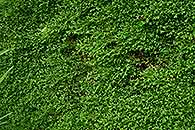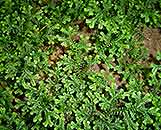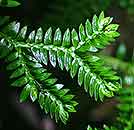Selaginella kraussiana (Kunze) A. Braun
Synonyms |
Lycopodium kraussianum Kunze |
|---|---|
Common name |
|
Description |
Plant widely creeping, mat-forming, up to 50 cm long, ultimate branches ascending, rooting for most of its length. Leaves dimorphic; lateral leaves oblong-elliptic, apex pointed, base rounded, unequal, 3-4 × 0.75-1.5 mm, lateral leaves larger and more spreading than median leaves; median leaves lanceolate to ovate-lanceolate, apex pointed, base cordate and unequal, margins finely toothed, 2-2.5 x 0.6-0.7 mm. Strobili situated on short side branches, 5-8 x 2 mm; sporophylls similar but narrower than the median leaves, of one type only. |
Notes | Can be confused with S. goudotiana which is more erect, roots are produced from the base of the stem only. S. mitteni is a smaller moss-like species that lies flat against the ground. |
Derivation | kraussiana: type specimen collected by Dr. F. von Krauss (1812-1890), a German naturalist & director of the Natural History Museum in Stuttgart. |
Habitat | On forest floor in moist evergreen forest, often where a break in the canopy slightly increases the light intensity; extends up to montane regions, erica zone, bamboo and grasslands. |
Distribution worldwide | Africa, Azores, Canary Isl., Madeira, naturalised in parts of S Europe. |
Distribution in Africa |
Angola, Burundi, Cameroon, Congo, Dem. Republic of Congo, Equatorial Guinea (incl. Bioko), Ethiopia, Kenya, Malawi, Mozambique, Rwanda, Sierra Leone, South Africa, Sudan and South Sudan, Swaziland, Tanzania , Uganda, Zimbabwe. |
Growth form |
Terrestrial. |
Literature |
|


